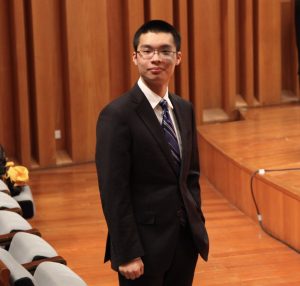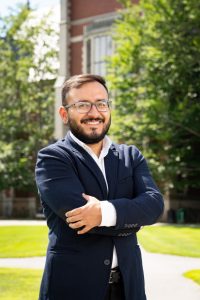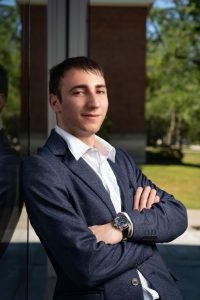Welcome to the 2022 Bowdoin International Music Festival Composer’s Concert! This summer features the talented composers Sam Wu, Kai Kubota-Enright, (Luís) Daniel Jiménez Rojas, Younje Cho, Zihan Wu, Sami Seif, Xiaofeng Jiang, Benjamin Norbrook, and Kate Ragan.
 Sam Wu // Melbourne, Australia // Age 27 // Composition: “Acadiana” // played by: Lauren Conroy, violin
Sam Wu // Melbourne, Australia // Age 27 // Composition: “Acadiana” // played by: Lauren Conroy, violin
Sam Wu’s composition, Acadiana, made its inaugural debut to the public on July 30 at the Bowdoin College Museum of the Art. Wu grew up passionate about the visual arts but later transitioned to a musical focus, training professionally in violin and piano. This long-standing passion for the visual arts usually acts as Wu’s starting point when creating many of his original pieces, hence why the “Composers at the Museum” was such an appropriate program for him to partake in.
This summer, Thomas Cole’s House, Mount Desert, Maine (1845), currently shown in the Bowdoin College Museum of Art’s At First Light: Two Centuries of Artists in Maine was the originating inspiration for Wu’s creative process. Both Wu’s music and Cole’s painting touch on the serenity and beauty the Maine landscape has to offer to visual and musical artists alike. The beauty of Cole’s piece prompted Wu to think more creatively about one of his favorite expeditions embarked during his time in Maine: visiting Acadia National Park. Acadia offers a special point of connectivity to Wu, as he received a “scratch-off-map” of all the national parks as a child, and aims to complete the map in his lifetime. Sam Wu’s solo violin composition is divided into three movements that depict his favorite aspects of Acadia. The first movement is inspired by the mist surrounding the porcupine islands, the second inspired by the beehive trail, and the third inspired by the sense of zen he felt at Jordan pond.
This is the second summer Wu has participated in the Bowdoin International Music Festival, and he currently acts as a teaching fellow for his peers. Wu speaks passionately about this festival offering a point of community building through the great equalizer of music. The festival gives him, as well as many other talented musicians, the privilege of making new friends and coexisting in the same spaces as many great performers. Collaborating with great musicians also offered Wu important critiques on his work “I am always trying to narrow the gap between what we imagine inside our minds and how it is actually perceived collaborating with others”. Wu will continue his work by pursuing a Doctorate of Musical Arts in Composition from Rice University’s Shepherd School of Music.
Xiaofeng Jiang // China // Age: 25 // Composition: “…As The Reflection of the Green Ripples in the Water…” // played by: Lauren Conroy, violin • Yunwen Chen, cello
Composer Xiaofeng Jiang spent her summer at the Bowdoin International Music Festival working on a duetted Cello and Violin piece based on Ashley Bryant’s Spruce, Soli Deo Gloria (1950) and Alex Katz’s Untitled (Skowhegan, Maine landscape) (1960), both currently featured in the Bowdoin College of Art’s exhibition At First Light: Two Centuries of Artists in Maine. These two paintings, displayed side-by-side in the gallery, demonstrate two different responses to the Maine landscape. Katz’s landscape is expressed through flat shapes and loose brush strokes, illustrating a large tree reflected at the edge of a pool of water. Ashley’s piece, by contrast, is a fluid collection of lines and colors that come together in the form of an abstract tree.
Jiang’s creative interpretation offers a comparison of Katz’s and Bryant’s paintings as two parts of a whole: Katz’s piece representing a tree, Bryant’s representing a reflection of said tree. Jiang’s work is one movement divided into three parts, aiming to encapsulate the meaning of reflections and shadows. In the first section, the strings create sounds that mimic the rustling of branches and leaves in the landscape, hoping to provide a sense of the atmosphere to the listeners. The second section aims to replicate Bryant’s intertwined lines, creating a sound difficult for the viewer to differentiate between individual instruments. The third and final section of Jiang’s composition is about chasing the movement of the aforementioned reflections and shadows in the landscape.
While Jiang is familiar with creating musical compositions, this project presented a different kind of challenge than her previous experiences. Jiang’s musical interests are to explore the relationship between the musical and natural world, as well as to create a bridge between auditory and visual arts. New work like this composition motivates her to continue diving deeper into the difficult task of appropriating and responding to other artists’ work with intent and truth.
Zihan Wu // China // Age: 20 // Composition: “Movement, Grey and Blue” // played by: Tianyu Liu, violin • Judy Hu, percussion
Zihan Wu, a current student at the Eastman School of Music, worked this summer on a violin and percussion piece inspired by and named after John Marin’s work Movement, Grey and Blue (1952), currently on view at the BCMA. Wu’s composition envisions the musicality within Marin’s art, imagining a scene in which a Siren uses her voice to attract surrounding boatmen. Wu was first enthralled by the abstract, loose lines of the painting, translating that sense of abstraction into her own musical composition.
The structure of Wu’s piece echoes the structure of John Marin’s work. Where Marin’s use of loose lines created a seemingly circular space, Wu’s piece similarly begins with an atmospheric and loose sound. Where the lines in Marin’s piece begin to create recognizable patterns and subjects, Wu’s piece similarly forms a gradual tension which explodes in the middle section, then recedes back to nothingness. In Zihan Wu’s music, the sounds of the violin, percussion, and human voice represent the diverse lines and brush strokes interacting with each other naturally, creating a unified yet unique sonority, echoing the abstract style of the painting.
Wu works to compose a diverse repertoire of musical sounds, instruments, and ideas. Combining the different elements of the instrumentation, violin, and percussion was a challenge due to the difficulty of balance and the incompatibility of timbre. Wu’s peers describe her piece as “new, engaging, and special” and say that the addition of a human voice adds a ghost-like feeling. Wu’s work goes beyond the typical confines of instrumental composition, creating a wholly original piece. “I like that I tried something new in this project, especially in a short amount of time,” she said.
Luis Daniel Jimenez // Mexico // Age: 27 // Composition: “Árboles” // played by: Jeremy Tai, cello
For the duration of Luis Daniel Jimenez’s time spent at the Bowdoin International Music Festival, he worked on a composition inspired by Ashley Bryant’s Spruce, Soli Deo Gloria (1950). Taken by Ashley Bryant’s abstract interpretations of a tree, Jimenez tries to imagine which types of trees she sought inspiration from. Jimenez’s piece Árboles, written for cello solo, is divided in four movements, each representing a different type of tree that Bryant may have seen or taken inspiration from:
- Él, que se ve triste, porque el aire lo ha doblado – He, who looks sad, because the air has bent him.
- Tan alto, que ni la punta logro ver – So high, that I can’t even see the tip.
- Tan rojo, que tiene misterio en sus hojas – So red, that it has mystery in its leaves.
- Joven todavía, probablemente me vaya primero de este mundo – Still young, I’ll probably leave this world first.
Jimenez sought out the opportunity to participate in the BIMA to further his interests in making a career in musical composition. After five weeks here at Bowdoin, Jimenez feels as though the friends he made here are like family, and he also got a taste of what it means to be a Mainer. Through his work, he hopes to communicate how a Mexican composer experiences Maine and its rare and unique landscape.
Sami Seif // Lebanon // Age: 24 // Composition: “Syriac Fugato 2” // played by: Natalie Clarke and Dominick Douglas, viola
Composer Sami Seif is from Ashkout and Ghazir, two beautiful small towns in the mountains of Lebanon, yet spent the majority of his 2022 summer here in Maine. He was drawn to the BIMF because of wonderful staff members such as Derek and Andreia, recommendations from his friends, the promise of meeting and connecting with other stellar performers, and Bowdoin’s beautiful campus. Seif’s composition, Syriac Fugato 2, is based on the BCMA’s collection of Assyrian reliefs, which are monumental slabs of gypsum alabaster. Each one is masterfully carved to represent important beliefs, leaders, and education in 883-859 BCE Iraq. Sami was inspired by Relief panel with Apkallu (Winged Spirit) Anointing King Ashurnasirpal II (883-859 BCE), Relief Panel with Apkallu (Winged Spirit) (883-859 BCE), Relief Panel with Apkallu (Winged Spirit) and Sacred Tree (883-859 BCE), and Relief Panel with Winged, Eagle-Headed Spirits (883-859 BCE). Sami’s Composition is part of a larger series that explores Middle Eastern identity.
Syriac Fugato 2 expresses a large variance of moods. It traces a journey from slow, calm, and meditative melody, to very rapid and intense sound, then repeats this cyclical journey. The sounds of the viola are reminiscent of typical Middle Eastern music, with an emphasis on melody and rhythm rather than harmony. According to Seif, his musical explorations often center around our perception of time, and our perspective and focus on musical objects. It is one of the great powers and mysteries of music that it can leave us feeling that musical time transcends chronometric time.” Creating a modernized piece of work based on ancient artifacts perfectly encapsulates Seif’s very ability to make art that transcends time, space, and geographies.
Other artists in this program
Benjamin Norbrook // Composition: “Two Maine Visions” // played by: Samuel Zacharia, viola • Isabel Atkinson, bass • Isabelle Scott, harp Jack Fischer, percussion
This piece was inspired by: George Hawley Hallowell, The Log Drivers (1903), oil on canvas. As well as Andrew Wyeth, Night Hauling (1944) tempera on masonite.
Kate Ragan // Composition: “Fractured Water” // played by: Scott Chiu, clarinet
This piece was inspired by: Berenice Abbott, Log Run, View from Boat (1965), gelatin silver print on paper.
Kai Kubota-Enright // Composition: “Apertures” // played by: Natalie Clarke, Samuel Zacharia, Dominick Douglas, viola • Jack Fischer, percussion
This piece was inspired by: Richard Tuttle, Untitled (One of the 3rd Group of Spiral Notebook Drawings to be Hung at a Height 53″ (Top Edge) High from the Floor in the Center of White Wall with glue at Top Corners) (1975) graphite, incisions on cut and folded paper.
Younje Cho // Composition: “Virtual Cloud” // played by: JuHyun Lee, clarinet • Dylan Kinneavy, cello • Amy Ahn, harp
This piece was inspired by: Katherine Bradford, Fear of Dark (2020) acrylic on canvas.


